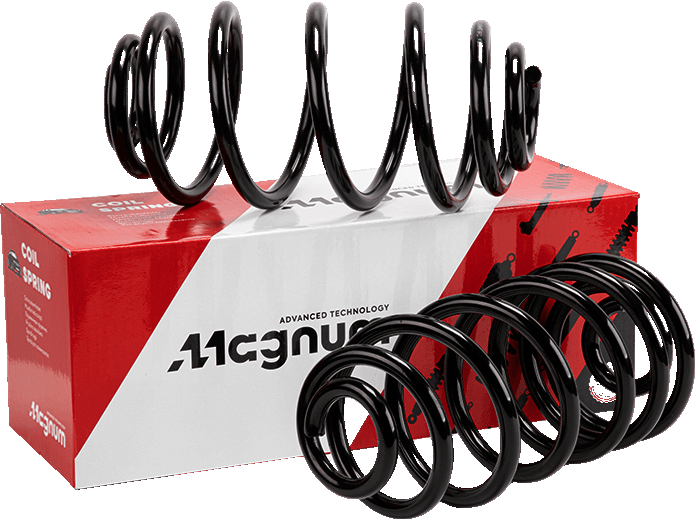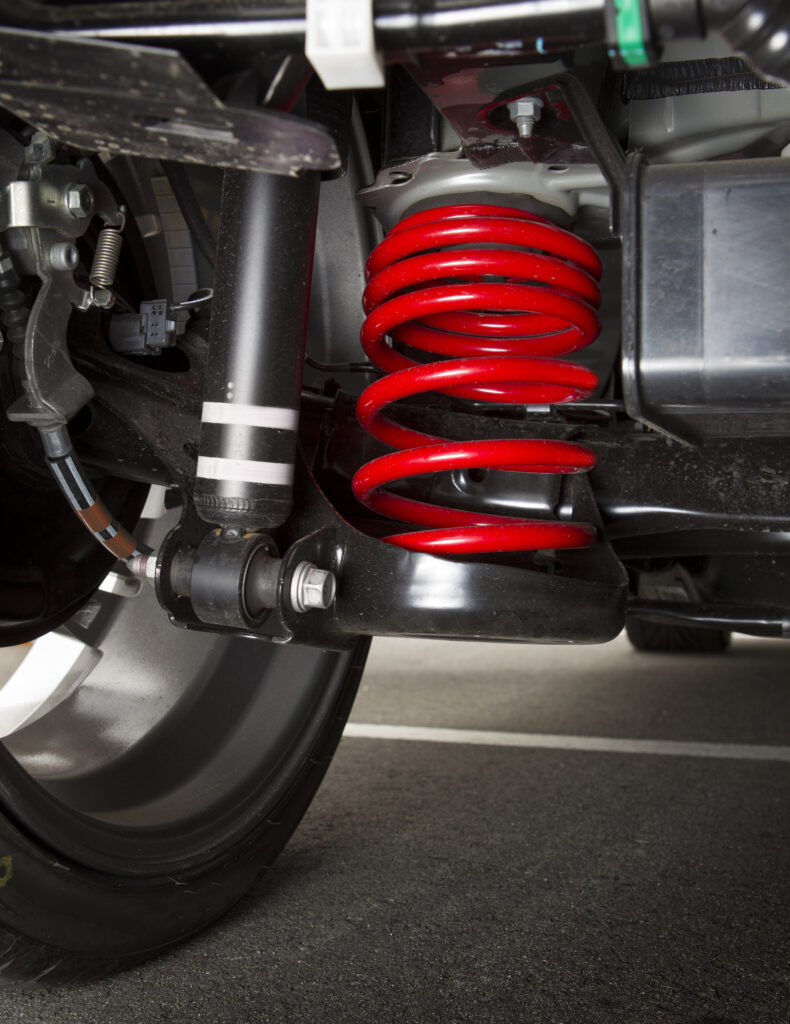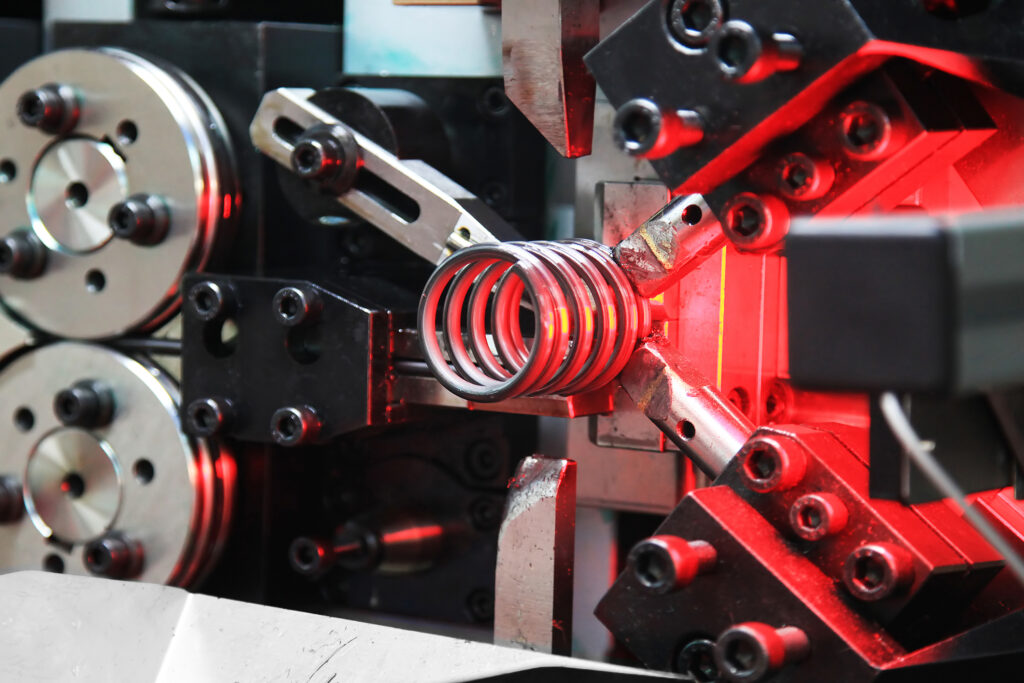Suspension springs – design, types, operation
The car suspension is made up of many components. One of the most important ones are the coil springs, which are dominant in contemporary cars. How are suspension springs designed, what are they responsible for and how to tell their failure? Check the most important information.

What is a suspension spring?
The automotive suspension system consists of three basic groups of components: coil springs, damping components and leading components. Coil springs belong to the first category, i.e., the springing elements in the car structure. Their construction is very simple, as they are made of thick steel wire formed into an appropriate shape. Coil springs vary in wire thickness, number of coils and their density. There may be a shock absorber inside the spring, in which case we speak of a suspension strut. This is the case with MacPherson struts.
In modern cars, coil springs – available from Magnum, for example – have replaced another type of spring, the leaf spring. These were characterised by their high resistance to overload, but required lubrication, took up a lot of space and did not guarantee as good drive as the modern type of spring. Leaf springs can still be found on trucks and utility cars. They are mainly used on rear axle wheels. Other types of spring elements used in automotive applications include torsion bars, air spring elements and rubber buffers, also available from Magnum.
What is a coil spring responsible for?
It is difficult to imagine modern cars without suspension. Spring elements, including coil springs, are necessary to prevent shocks and vibrations generated during driving from being transmitted to the passenger compartment. Suspension springs are mounted between the swingarm and the stringer and connect the unsprung mass (wheels, tyres, brakes, etc.) to the sprung mass, i.e., the rest of the car. In this way, the body is somehow separated from the road surface and the movement of the car on the road is smoother.
The suspension springs also press the wheels against the road and maintain a constant ground clearance. A spring expands when a wheel enters a pothole and compresses when a wheel hits a bump. However, to prevent the car from rocking and the wheel from separating from the road, the action of the springs is dampened by a shock absorber.
The energy accumulated in the springs is transferred to the shock absorber and converted into heat. The spring itself does not guide the wheel, so it works in conjunction with the swingarm or multi swing-arm system.
Constant or variable diameter springs?
Most passenger cars have a suspension based on fixed diameter springs. These springs have linear characteristics, which means that they offer a similar level of resistance along their entire length. However, in some cases progressive springs are used, with variable core thickness, different coil density or an unusual shape.
Such springs tend to be more compact, which is useful in low-slung cars, and also have non-linear performance characteristics. This means that the tighter a spring is compressed, the more resistance it will offer. The thickest coils are located in the middle of the spring. Progressive suspension is characterised by good response to low-amplitude vibrations and high stiffness under higher loads. For this reason, progressive springs are better able to withstand overloading.
Coil springs in threaded suspensions
Threaded suspensions with height and hardness adjustment are also used in sports cars. By adjusting the seating of the springs, the ground clearance of the car can be reduced and the hardness of the suspension can also be adjusted. A lower-set car with firmer springs has better handling and less rocking when cornering. On the other hand, low suspension travel can be a problem on large bumps and strongly affects comfort.

There are also kits available online to lower your car. Most of them are simply shorter springs than the serial ones and even by 5 cm. According to the seller, using shorter springs will improve the car’s handling characteristics, but this is not always true. Suspension geometry is designed for a specific spring length and all suspension components should work within the same range. If the springs themselves are changed, the shock absorber will not work to its full potential and the wheel may be misaligned. In some cases, the spring may even break out of its seat, which is very dangerous. We do not recommend that you modify your suspension yourself, without consulting a specialist and adjusting the other parts.
Symptoms of worn suspension springs
Suspension springs are maintenance-free and their wear is difficult to identify. Steel springs lose their spring rate over time, causing the car to lower its ground clearance slightly and the suspension to become softer. However, this is not noticeable when driving and does not always have a negative effect on the car’s handling. Unlike leaf springs, there is no friction between the coils of coil springs, so the risk of seizing, overheating or chipping is minimal.
The biggest change in suspension performance can only be noticed when a spring fails. Most often the spring breaks, mainly on the initial coils. The main reason for cracks near the seats is advanced corrosion, but they can also occur when the car is overloaded. This risk applies for example to utility cars or cars equipped with a gas system. A heavy fuel tank filled with liquid gas puts a heavy load on the rear axle springs and can accelerate their wear.
Cracks in the suspension springs are very dangerous and can lead to dangerous situations on the road. In such a case, the wheel will lose its spring rate and the control arm will rest on a damaged spring or rubber buffer. This renders further driving impossible. Some cracks, however, are less serious and, moreover, not so easy to detect. A spring broken at the end coils may remain in its seat and not affect the behaviour of the car too much. Typical symptoms are rattling noises from the suspension when accelerating, braking, cornering or driving over bumps.

What to bear in mind when replacing coil springs?
If you notice corrosion or cracks in your springs, replace them immediately. Just like shock absorbers, both coil springs should be replaced on both wheels of an axle. Usually only one of the springs breaks, but leaving the other spring and adding a new one to it will lead to a disproportion in spring rate. The new one will be harder, higher and more resilient than the used one.
How to check the wear of your springs? The easiest way is to regularly check their height. Identifying excessive compression then will not be difficult. An unnatural position of the car or a lowering of the suspension that is visible at a glance should also be a warning light.
The condition of the springs and seats should also be checked during a shock absorber test. Effective damping depends not only on the performance of the shock absorbers, but also on the performance of the springs. Heavily worn or corroded springs can give uneven resistance, which will affect the measurement.
It is advisable to have your shock absorbers replaced by a reliable garage. Although replacing the spring, through which the shock absorber does not pass, is relatively easy, the suspension geometry must still be checked afterwards. The experience of a mechanic is even more important when replacing a MacPherson strut spring, which requires the use of special spring extractors. Unscrewing the column fixing bolt without using the pullers risks a dangerous shot of the spring and nut.
